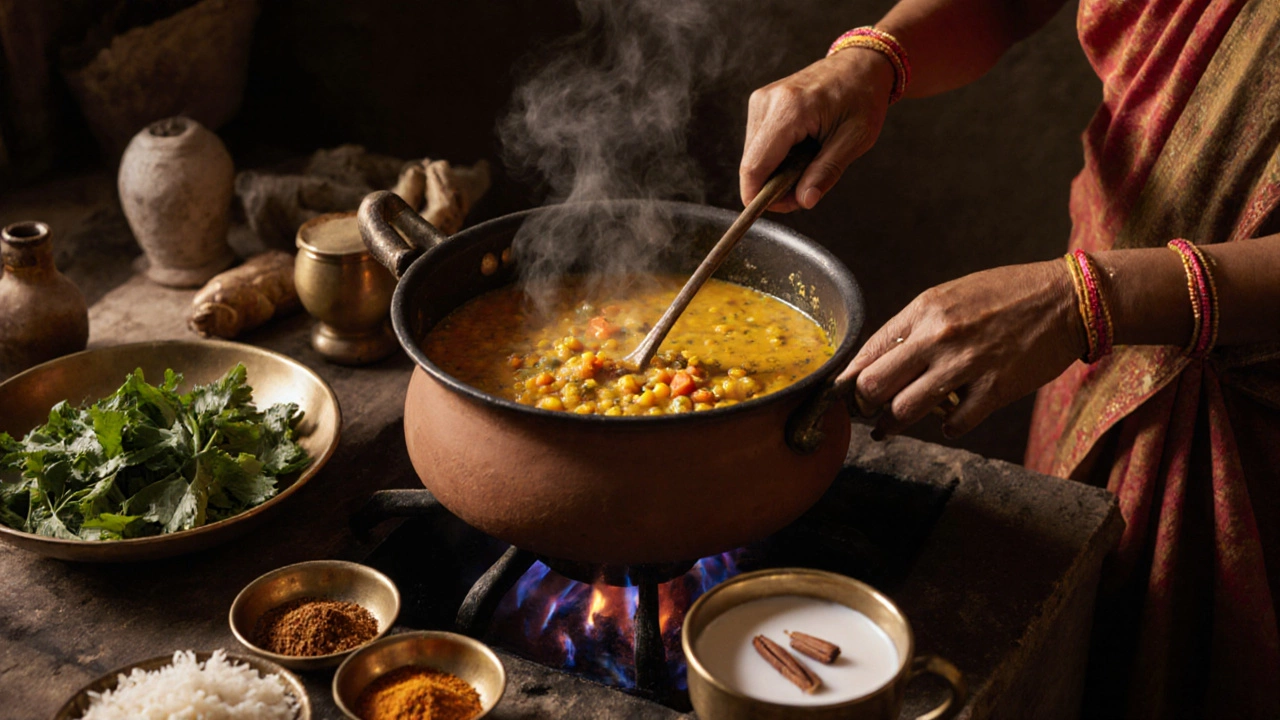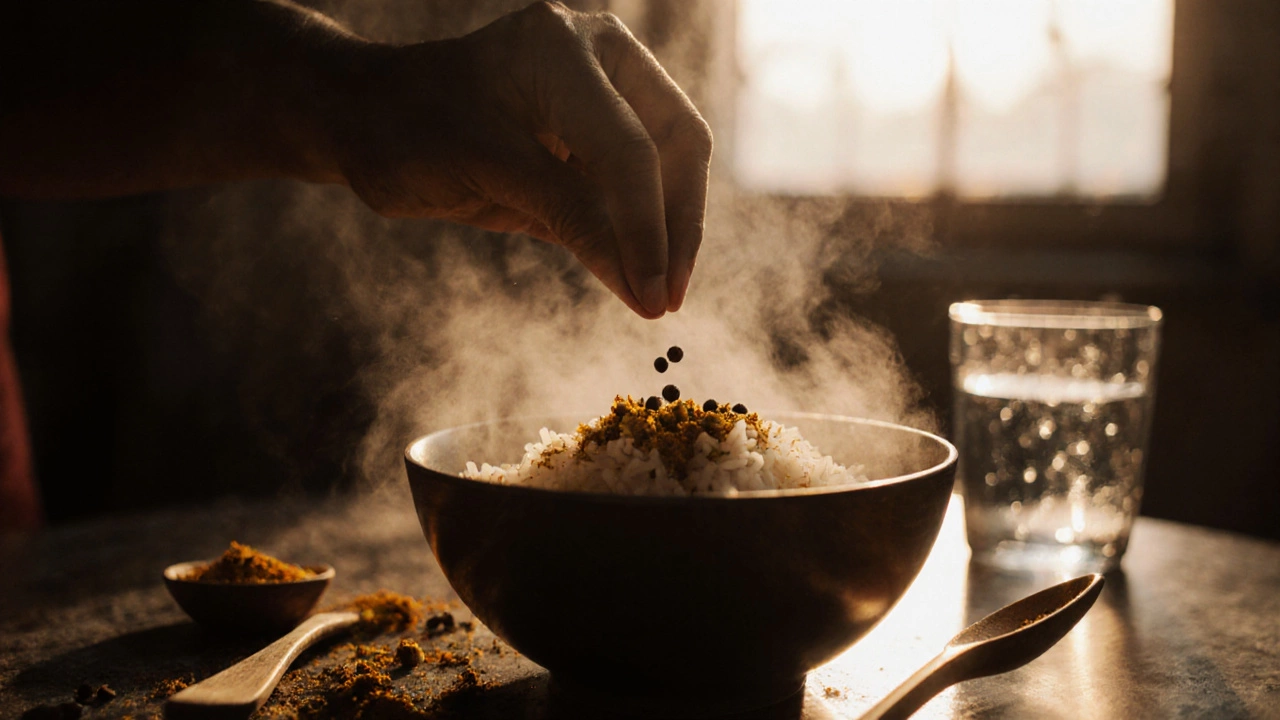
Ever felt like no matter what diet you try, your body just doesn’t respond the way it should? You eat clean, skip sugar, count calories-but still feel bloated, tired, or anxious? That’s not your fault. Most diets treat everyone the same, but your body isn’t like everyone else’s. The Ayurvedic diet doesn’t ask you to follow rules. It asks you to listen.
What is an Ayurvedic diet?
The Ayurvedic diet comes from Ayurveda, a 5,000-year-old system of healing from India. It’s not about losing weight fast or cutting out carbs. It’s about eating in a way that matches your unique body type, called your dosha. Think of dosha like your biological fingerprint-your natural balance of energy, digestion, sleep patterns, and even how you handle stress.
There are three doshas: Vata, Pitta, and Kapha. Most people have a mix, but one usually dominates. The Ayurvedic diet works by balancing your dominant dosha with the right foods, spices, and eating habits. It’s not a one-size-fits-all plan. It’s a personalized rhythm.
How doshas shape your eating habits
Each dosha has its own needs. Vata types tend to be thin, quick-moving, and prone to anxiety or constipation. They need warm, oily, grounding foods-like cooked grains, soups, and root vegetables. Raw salads and cold smoothies? Those can make them feel unsteady.
Pitta types are often fiery-sharp-minded, strong digestion, maybe prone to heartburn or anger. They thrive on cooling, sweet, bitter foods: cucumber, coconut, leafy greens, and barley. Spicy chilies, fried snacks, and coffee? They’ll turn up the heat too high.
Kapha types are steady, strong, and slow to change. They can gain weight easily and feel sluggish. They need light, dry, spicy foods: lentils, broccoli, ginger tea, and pungent spices. Heavy dairy, sweet desserts, and fried foods? Those just weigh them down.
Knowing your dosha isn’t about labeling yourself. It’s about noticing what happens when you eat certain things. Do you feel light and clear after a warm, spiced lentil soup? Or do you feel heavy and sleepy after a big salad? Those are your body’s signals.
What you actually eat on an Ayurvedic diet
Forget restrictive lists. The Ayurvedic diet focuses on whole, fresh, seasonal foods. Most meals are built around:
- Whole grains: rice, quinoa, oats, barley
- Lentils and legumes: moong dal, chickpeas, red lentils
- Seasonal vegetables: especially cooked ones
- Healthy fats: ghee, coconut oil, sesame oil
- Spices: turmeric, cumin, coriander, ginger, fennel
- Fresh fruits: apples, pears, berries, cooked prunes
- Dairy: warm milk, small amounts of ghee or paneer
Processed sugar, artificial flavors, frozen meals, and leftover food are avoided. Ayurveda says food loses its life force after six hours. Leftovers aren’t just less tasty-they’re harder to digest.
One key rule: eat your biggest meal at lunch. That’s when your digestive fire, or agni, is strongest. Breakfast is light-warm porridge or fruit. Dinner is the smallest, eaten at least three hours before bed.
Why spices matter more than you think
Spices aren’t just for flavor in Ayurveda. They’re medicine. Cumin helps digestion. Turmeric reduces inflammation. Ginger wakes up your metabolism. Fennel calms bloating. Coriander cools Pitta.
Most Ayurvedic meals include a spice blend called panchamahabhuta or tridoshic masala-a mix of cumin, coriander, fennel, black pepper, and turmeric. Even if you don’t know your dosha, this blend works for everyone. Add it to soups, rice, or roasted veggies. It’s the simplest way to start.
Don’t overdo it. Too much spice can irritate Pitta. Too little can leave Vata feeling ungrounded. Balance is everything.

When and how you eat matters more than what you eat
It’s not just about the food. It’s about how you eat.
- Always sit down. No eating while scrolling, driving, or working.
- Chew slowly. At least 20 chews per bite. Digestion starts in your mouth.
- Drink warm water. Cold drinks slow digestion. Sip warm water with meals, not large amounts.
- Don’t eat when upset. Stress shuts down digestion. Wait until you’re calm.
- Stop before you’re full. Ayurveda says fill half your stomach with food, a quarter with water, and leave a quarter empty.
These habits are simple. But they change everything. People who follow them often say they stop feeling bloated, sleep better, and have more energy-even without changing what they eat.
What the Ayurvedic diet is not
It’s not a vegan diet. It’s not a keto diet. It’s not a detox cleanse.
You can eat meat on an Ayurvedic diet-but only if your dosha needs it. Vata types might have small amounts of chicken or fish. Kapha types are usually advised to avoid meat. Pitta types can handle it in moderation.
It’s not about perfection. If you eat something that doesn’t suit your dosha once in a while? It’s okay. Ayurveda isn’t rigid. It’s about awareness. Notice how you feel afterward. That’s the real practice.
How to find your dosha
You don’t need a doctor to find your dosha. Start by answering a few simple questions:
- Do you tend to feel cold easily? (Vata)
- Do you get hot, sweaty, or irritated easily? (Pitta)
- Do you gain weight easily and feel sluggish? (Kapha)
- Do you have dry skin or hair? (Vata)
- Do you have strong appetite and sharp digestion? (Pitta)
- Do you have thick, oily skin and slow metabolism? (Kapha)
Take a free online dosha quiz from trusted Ayurvedic sites. Or just observe yourself for a week. What foods make you feel good? What makes you feel off? That’s your guide.
If you’re still unsure, start with the universal basics: eat warm, cooked food. Use ginger, cumin, and turmeric. Avoid ice water and processed snacks. Eat at regular times. That’s enough to begin.

Real results people see
People in Bangalore, Mumbai, and even in cities abroad who switch to this way of eating often report:
- Less bloating after meals
- More regular digestion
- Improved sleep without sleeping pills
- Stable moods-not swinging between energy crashes and anxiety
- Weight loss without counting calories
One woman I know, a teacher in Mysore, struggled with fatigue for years. She tried keto, intermittent fasting, protein shakes. Nothing worked. Then she started eating warm lentil soup for dinner, drank ginger tea after meals, and stopped eating after 7 PM. Within two weeks, she slept through the night. Her energy came back. She didn’t lose weight-but she felt lighter.
Where to start today
You don’t need to overhaul your life. Start small:
- Replace your morning coffee with warm water and lemon.
- Add a pinch of turmeric and black pepper to your lunch rice.
- Eat your biggest meal at noon-not dinner.
- Chew each bite 15 times.
- Stop eating two hours before bed.
Do this for 10 days. Notice how you feel. Then adjust. That’s Ayurveda.
This isn’t a diet you follow for a month. It’s a way of living with your body-not against it. It’s ancient, simple, and quietly powerful.
Can I eat dairy on an Ayurvedic diet?
Yes, but it depends on your dosha. Warm milk with a pinch of cardamom is great for Vata. Kapha types should limit dairy, especially cheese and ice cream. Pitta types can have small amounts of ghee or fresh paneer. Avoid cold milk, yogurt at night, and processed dairy products.
Is the Ayurvedic diet vegetarian?
Most Ayurvedic diets are plant-based, but not always. Meat is allowed for Vata types in small amounts-like chicken or fish. Kapha types are usually advised to avoid it. Pitta types can have it occasionally. The focus is on digestion, not strict rules. If meat doesn’t suit your body, skip it.
Can I drink coffee on an Ayurvedic diet?
Coffee is heating and drying, so it’s best for Kapha types who need stimulation. It’s not ideal for Vata (can cause anxiety) or Pitta (can cause acidity). If you drink it, have it warm, with a little milk or ghee, and never on an empty stomach. Herbal teas like ginger or fennel are better daily choices.
How long does it take to see results?
Most people notice changes in digestion, sleep, or energy within 7-14 days. Deeper changes-like emotional balance or weight regulation-take 4-8 weeks. Ayurveda works slowly because it’s healing the root, not masking symptoms.
Do I need to buy special foods or supplements?
No. You don’t need expensive superfoods or pills. Basic ingredients like rice, lentils, ghee, turmeric, cumin, and fresh vegetables from your local market are enough. Ayurveda is about using what’s simple, local, and seasonal-not buying into trends.
What to do next
Start by eating one warm meal a day. Add a spice you’ve never used before-maybe cumin or fennel. Sit down without your phone. Chew slowly. Notice how you feel after. That’s all it takes. Ayurveda isn’t about doing more. It’s about doing less-and paying attention.

Write a comment